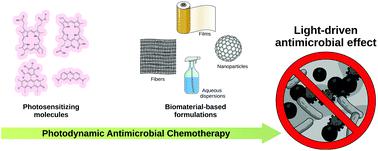当前位置:
X-MOL 学术
›
Photochem. Photobiol. Sci.
›
论文详情
Our official English website, www.x-mol.net, welcomes your feedback! (Note: you will need to create a separate account there.)
Conjugating biomaterials with photosensitizers: advances and perspectives for photodynamic antimicrobial chemotherapy.
Photochemical & Photobiological Sciences ( IF 3.1 ) Pub Date : 2020-02-14 , DOI: 10.1039/c9pp00398c Nidia Maldonado-Carmona 1 , Tan-Sothea Ouk , Mário J F Calvete , Mariette M Pereira , Nicolas Villandier , Stephanie Leroy-Lhez
Photochemical & Photobiological Sciences ( IF 3.1 ) Pub Date : 2020-02-14 , DOI: 10.1039/c9pp00398c Nidia Maldonado-Carmona 1 , Tan-Sothea Ouk , Mário J F Calvete , Mariette M Pereira , Nicolas Villandier , Stephanie Leroy-Lhez
Affiliation

|
Antimicrobial resistance is threatening to overshadow last century's medical advances. Previously eradicated infectious diseases are now resurgent as multi-drug resistant strains, leading to expensive, toxic and, in some cases, ineffective antimicrobial treatments. Given this outlook, researchers are willing to investigate novel antimicrobial treatments that may be able to deal with antimicrobial resistance, namely photodynamic therapy (PDT). PDT relies on the generation of toxic reactive oxygen species (ROS) in the presence of light and a photosensitizer (PS) molecule. PDT has been known for almost a century, but most of its applications have been directed towards the treatment of cancer and topical diseases. Unlike classical antimicrobial chemotherapy treatments, photodynamic antimicrobial chemotherapy (PACT) has a non-target specific mechanism of action, based on the generation of ROS, working against cellular membranes, walls, proteins, lipids and nucleic acids. This non-specific mechanism diminishes the chances of bacteria developing resistance. However, PSs usually are large molecules, prone to aggregation, diminishing their efficiency. This review will report the development of materials obtained from natural sources, as delivery systems for photosensitizing molecules against microorganisms. The present work emphasizes on the biological results rather than on the synthesis routes to prepare the conjugates. Also, it discusses the current state of the art, providing our perspective on the field.
中文翻译:

生物材料与光敏剂的结合:光动力抗微生物化学疗法的进展和前景。
抗菌素耐药性正威胁着上世纪医疗技术的发展。以前被根除的传染病现在作为多药耐药菌株而重新流行,导致昂贵,有毒的抗菌疗法在某些情况下无效。鉴于这种前景,研究人员愿意研究可能能够应对抗菌素耐药性的新型抗菌疗法,即光动力疗法(PDT)。PDT依赖于在光和光敏剂(PS)分子存在下产生有毒的活性氧(ROS)。PDT已经有近一个世纪的历史了,但是它的大多数应用都是针对癌症和局部疾病的治疗。与经典的抗微生物化学疗法不同,光动力抗微生物化学疗法(PACT)具有非靶标特异性作用机制,基于ROS的生成,可作用于细胞膜,壁,蛋白质,脂质和核酸。这种非特异性机制减少了细菌产生抗药性的机会。但是,PS通常是大分子,易于聚集,从而降低了效率。这篇综述将报道从自然资源获得的材料的发展情况,这些材料可以作为分子对微生物进行光敏的传递系统。本工作着重于生物学结果,而不是制备缀合物的合成途径。此外,它还讨论了当前的技术现状,并提供了我们对该领域的看法。脂质和核酸。这种非特异性机制减少了细菌产生抗药性的机会。但是,PS通常是大分子,易于聚集,从而降低了效率。这篇综述将报道从自然资源获得的材料的发展情况,这些材料可以作为分子对微生物进行光敏的传递系统。本工作着重于生物学结果,而不是制备缀合物的合成途径。此外,它还讨论了当前的技术现状,并提供了我们对该领域的看法。脂质和核酸。这种非特异性机制减少了细菌产生抗药性的机会。但是,PS通常是大分子,易于聚集,从而降低了效率。这篇综述将报道从自然资源获得的材料的发展情况,这些材料可以作为分子对微生物进行光敏的传递系统。本工作着重于生物学结果,而不是制备缀合物的合成途径。此外,它还讨论了当前的技术现状,并提供了我们对该领域的看法。作为使分子对微生物敏感的传递系统。本工作着重于生物学结果,而不是制备缀合物的合成途径。此外,它还讨论了当前的技术现状,并提供了我们对该领域的看法。作为使分子对微生物敏感的传递系统。本工作着重于生物学结果,而不是制备缀合物的合成途径。此外,它还讨论了当前的技术现状,并提供了我们对该领域的看法。
更新日期:2020-02-14
中文翻译:

生物材料与光敏剂的结合:光动力抗微生物化学疗法的进展和前景。
抗菌素耐药性正威胁着上世纪医疗技术的发展。以前被根除的传染病现在作为多药耐药菌株而重新流行,导致昂贵,有毒的抗菌疗法在某些情况下无效。鉴于这种前景,研究人员愿意研究可能能够应对抗菌素耐药性的新型抗菌疗法,即光动力疗法(PDT)。PDT依赖于在光和光敏剂(PS)分子存在下产生有毒的活性氧(ROS)。PDT已经有近一个世纪的历史了,但是它的大多数应用都是针对癌症和局部疾病的治疗。与经典的抗微生物化学疗法不同,光动力抗微生物化学疗法(PACT)具有非靶标特异性作用机制,基于ROS的生成,可作用于细胞膜,壁,蛋白质,脂质和核酸。这种非特异性机制减少了细菌产生抗药性的机会。但是,PS通常是大分子,易于聚集,从而降低了效率。这篇综述将报道从自然资源获得的材料的发展情况,这些材料可以作为分子对微生物进行光敏的传递系统。本工作着重于生物学结果,而不是制备缀合物的合成途径。此外,它还讨论了当前的技术现状,并提供了我们对该领域的看法。脂质和核酸。这种非特异性机制减少了细菌产生抗药性的机会。但是,PS通常是大分子,易于聚集,从而降低了效率。这篇综述将报道从自然资源获得的材料的发展情况,这些材料可以作为分子对微生物进行光敏的传递系统。本工作着重于生物学结果,而不是制备缀合物的合成途径。此外,它还讨论了当前的技术现状,并提供了我们对该领域的看法。脂质和核酸。这种非特异性机制减少了细菌产生抗药性的机会。但是,PS通常是大分子,易于聚集,从而降低了效率。这篇综述将报道从自然资源获得的材料的发展情况,这些材料可以作为分子对微生物进行光敏的传递系统。本工作着重于生物学结果,而不是制备缀合物的合成途径。此外,它还讨论了当前的技术现状,并提供了我们对该领域的看法。作为使分子对微生物敏感的传递系统。本工作着重于生物学结果,而不是制备缀合物的合成途径。此外,它还讨论了当前的技术现状,并提供了我们对该领域的看法。作为使分子对微生物敏感的传递系统。本工作着重于生物学结果,而不是制备缀合物的合成途径。此外,它还讨论了当前的技术现状,并提供了我们对该领域的看法。


























 京公网安备 11010802027423号
京公网安备 11010802027423号